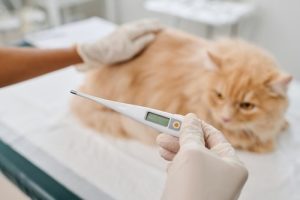A fever in cats occurs when their body temperature is higher than normal. The normal body temperature for a healthy adult cat should be between 38 and 39.2 °C. A normal temperature for kittens is lower than this, around 36-38℃.
A fever, high temperature, or pyrexia in your cat can be due to many different causes. These can vary from something mild to very serious, and they can be dangerous if not treated quickly.
What to do
What to do if you think your cat has a fever
We recommend a physical exam as soon as possible. If left untreated, a fever can lead to serious side effects. These include swelling of the brain and blood clotting problems, which can be fatal.
The most common symptoms we see in cats with a high temperature are
- Lethargy (low energy)
- Hiding or not moving
- Not wanting anything to eat or drink
- Shivering or stiffness
- Breathing faster than normal

Other signs can also develop, such as diarrhoea, vomiting, sneezing, coughing, and limping.
Our Joii team are available 24 hours a day for advice. Call us now if you have any questions.
Causes
The most common causes of fever in cats
Most common
- Cat bite abscess, caused by fighting with other cats.
- Viral infections: Cat flu, FeLV (Feline Leukaemia Virus), FIV (Feline Immunodeficiency Virus), FIP (Feline Infectious Peritonitis)
- Bacterial infections: Urine, kidney, or respiratory infections
- Parasites: Toxoplasma

Lesser common
- Immune-mediated conditions: IMHA (immune-mediated haemolytic anaemia)
- Pancreatitis
- Trauma leading to Wounds
- Fungal infections
- Medications: vaccines, some types of antibiotics. These reactions should be mild and self-resolve within 1-2 days.
- Poisons and toxins: insecticides such as organophosphates
- Lyme Disease / Tick Fever is rare in cats in the UK
- Cancer, such as lymphoma
Fever of Unknown Origin (FUO) is a term used when a cat has a persistent fever without an immediately obvious cause.
It’s important to note that fever and heat stroke are two separate conditions.
Heat stroke happens when the body’s temperature suddenly rises and it is unable to cool itself quickly. This is usually caused by a hot environment or physical activity.
Find out more about Heat stroke in cats
When to worry
When to worry about a fever in your cat
A fever that has not resolved within 48 hours can be life threatening!
Seek help from your local vet if
- Your cat is breathing faster than normal
- Your cat has had any of these symptoms for over 24 hours: Lethargy, not eating or drinking, shivering or shaking
Joii can help if
- Your cat has developed any of the symptoms mentioned, but it has been less than 24 hours.
- You’ve checked your cat’s temperature at home, and it is above 39.2 °C.
- Your cat has recently had a vaccine, and they are unwell afterwards.
- You have any questions about encouraging your cat with a fever to eat or drink.
Prevention
Tips on how to prevent fever in cats
- Keep your cat up to date with vaccinations, even if they are indoor cats.
- Check your cat regularly for any wounds or swellings on its body, especially if it goes outdoors.
- Use flea, tick, and worm preventative medication.
- Prevent access to any toxins, including human medications.
Cats can develop a high temperature due to stress, which should resolve quickly once they are in a cool, calm environment.
Diagnosis
How to tell if your cat has a fever
If your cat shows any of the symptoms above, we recommend getting them checked out by your local vet. They will be able to accurately check their temperature.
Unfortunately, it is impossible to tell if your cat has a fever by feeling the ears or bare skin. These areas can feel warm even when there is no fever present.
- Ear thermometers can be used at home to check your cat’s temperature, though these are not as accurate as rectal thermometers.
- Digital rectal thermometers are more accurate. We would only recommend this if you have previous experience under veterinary guidance. They can cause damage to the rectal tissue if used incorrectly.

Home treatment
How can I help at home if my cat has a fever?
If your cat has been diagnosed with a fever, you can help at home with the following
- Place bowls of fresh water within easy reach in several areas of the house.
- Allow them to rest, and make sure there is a safe, quiet place to sleep.
- Encourage eating. Feed soft, bland food, such as cooked white fish or chicken, or add water to their food and heat it slightly.
- Brush your cat regularly. If they are grooming less, this can prevent mats from forming.
Never give your cat any human medication, as this can be toxic!
Vet treatment
Vet treatment for fever in cats
Your vet will examine the whole body to look for abnormalities that could be causing the fever, such as wounds, lumps, or signs of trauma.
If there is an obvious cause, such as a cat bite abscess or a mild respiratory infection, then medication may help without any further tests.
If there is not an obvious cause on the initial exam, your veterinarian may suggest the following
- Blood tests to check the internal organs and red and white blood cells
- Blood tests to check for FIV, FeLV, and other infectious causes
- Urine tests
- Faecal tests
- Imaging such as x-rays, ultrasound, CT scan, or MRI
Treatment depends on the underlying cause but may include
- Antibiotics
- Non-steroidal anti-inflammatory medications
- Steroids
- Hospitalisation for fluids and monitoring
- Biopsy or surgery for any masses
Risk
Are some cats at more risk of developing a fever?
A fever can affect all ages, breeds, and sex of cats. The cause can be narrowed down based on these factors.
Infectious causes are more common in
- Young cats, especially males. Cat bite abscesses are common.
- Outdoor cats
- Unvaccinated cats
- Cats that have been abroad: Babesia, Leishmania, Ehrlichia, and Rabies
- Cats in households with many cats: FIP and FeLV
- Purebred cats: FIP, fungal infections
Neoplastic (cancer) causes are more common in
- Older cats
Do you want to know more about specific causes of fever in cats?
Cat Scratch Fever
- An uncommon condition caused by a bacteria called Bartonella. It can spread to humans and other animals via a cat bite or scratch.
- Cats get infected with this bacteria from flea bites, but they don’t often show symptoms of it.
- Immunocompromised and young people are most at risk.
- The most common symptoms in humans are blisters, headaches, lethargy, and fever. Cats often don’t show any symptoms. We recommend speaking with your doctor if you have any concerns about this.
Viral
- FIV: Infectious disease that attacks the immune system. Usually spread through cat bites. Symptoms include lethargy, reduced appetite, and weight loss. It can cause disease in other organs of the body.
- FeLV: Can vaccinate against. A severe disease that affects the immune system. Symptoms include weight loss, sore gums, and lethargy. Spread through infected saliva and shared bowls or bedding. The long-term outlook is poor.
- FIP: caused by a cat-specific coronavirus. It can be difficult to diagnose and treat. Symptoms include diarrhoea, sneezing, weight loss, lethargy, and seizures. They can also develop fluid in the chest and abdomen and breathing abnormalities. The long-term outlook is poor.
- Cat flu: Common illness caused by bacteria and viruses. Symptoms include runny eyes and nose, sneezing, and lethargy. Can vaccinate against this.
- Herpes virus: Common cause of cat flu and also eye problems. Cats can be lifelong carriers.
- Calicivirus: Highly contagious virus often associated with cat flu. Symptoms include a runny nose, inflamed gums, and ulcers in the mouth.
- Panleukopenia virus (FPV, feline infectious enteritis): Attacks the gut and immune system. Can vaccinate against this. Can be fatal, especially in younger cats. Symptoms include vomiting, diarrhoea, and lethargy.
- Rabies: A fatal disease that affects the brain and can spread to most mammals, including humans. The UK is rabies-free, but your pet may be at risk if they have travelled abroad. Usually spread through a bite or scratch from infected animals. Symptoms include behaviour changes, drooling, and difficulty walking.
Bacterial
- Cat bite abscess in cats: Occur after cat bites and occasionally scratches. Start as swelling under the skin and often rupture to produce smelly pus discharge. Symptoms include lethargy and reduced appetite.
- Tooth Root Abscesses: Severe infection around the root of the tooth, hidden under the gum. Treatment is often straightforward and successful. Symptoms include swelling below the eye, reluctance to chew, and bad breath.
- Campylobacter: Not common in cats. Symptoms include diarrhoea, vomiting, and a painful tummy. Can be worse in young cats and those with underlying health problems. Can spread to humans.
Parasites
- Toxoplasma: Can spread in soil, cat faeces, and raw meat. Some cats show no symptoms at all. Symptoms include not eating, lethargy, weight loss, and weakness. Can spread to humans.
Other
- Pancreatitis: Symptoms include vomiting, diarrhoea, tummy pain, and reduced appetite. The disease can range from mild to severe and can often also affect the liver and intestines.
- IMHA (immune-mediated haemolytic anaemia): Disease in which the immune system attacks its red blood cells. Life-threatening disease. The main symptoms include not eating, pale or yellow gums, and lethargy.








